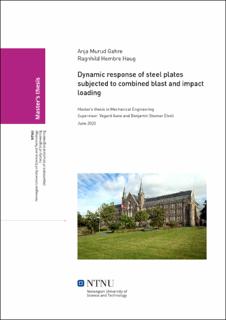| dc.contributor.advisor | Aune, Vegard | |
| dc.contributor.advisor | Elveli, Benjamin Stavnar | |
| dc.contributor.author | Gahre, Anja Murud | |
| dc.contributor.author | Haug, Ragnhild Hembre | |
| dc.date.accessioned | 2023-05-15T17:20:31Z | |
| dc.date.available | 2023-05-15T17:20:31Z | |
| dc.date.issued | 2020 | |
| dc.identifier | no.ntnu:inspera:56511028:20963221 | |
| dc.identifier.uri | https://hdl.handle.net/11250/3068043 | |
| dc.description.abstract | Denne oppgaven undersøker oppførselen til tynne stålplater, utsatt for en kombinasjon av støt- og eksplosjonslast. Både eksperimentelle og numeriske studier ble utført. Alle platene var av tykkelse 0.8 mm. Tre ulike stålkvaliteter med forskjellig styrke og duktilitet ble brukt. Strekktester ble utført på materialprøver for å etablere materialmodeller. Alle eksperimentene ble utført ved Structural Impact Laboratory (SIMLab), på institutt for konstruksjonsteknikk, Norges Teknisk-Naturvitenskapelige Universitet (NTNU). Ballistikk eksperimentene ble utført i gasskanonen, mens eksplosjonsforsøkene ble utført i SIMLab Shock Tube Facility (SSTF). AMP2 kuler ble brukt for ballistisk perforering. Kulehullet ble påført i midten av platen. Plater med forhåndsformede hull, med samme dimensjoner som tverrsnittet til prosjektilet, ble også utsatt for eksplosjonslast. To avfyringstrykk ble brukt. I tillegg ble eksplosjonslaster med fem intensiteter satt på plater uten hull for én stålkvalitet.
Lagrange-modeller ble brukt til numeriske studiet i LS-DYNA og sammenliknet med eksperimentelle observasjoner for validering. Den siste delen av det numeriske arbeidet innebar parameterstudier på bruddparameteren og parameteren for beskrivelse av materialers følsomhet for tøyningsrate.
Det ble funnet at bruddpropagering under eksplosjonslast var sterkt avhengig av den initielle sprekkdannelsen og skaden fra ballistisk perforering. Høy styrke og lav duktilitet ble funnet til å være mindre motstandsdyktig mot påfølgende eksplosjonslast sammenliknet med mer duktile, arbeidsherdende materialer. Allerede eksisterende skade fra prosjektilets perforering var mer destruktivt for platenes strukturelle respons enn boret hull. Numeriske studier var i stand til å forutsi bruddinitiering til en viss grad, men overdrev bruddpropageringen. Som forventet førte simplifiserte randbetingelser til mindre deformasjoner. Dette ble imidlertid funnet som et nødvendig kompromiss mellom nøyaktighet og beregningstid, slik at det skulle være mulig å gjennomføre de numeriske studiene med de tilgjengelige beregningsverktøyene i løpet av denne masteren. | |
| dc.description.abstract | This thesis investigates the behaviour of thin steel plates subjected to a combination of ballistic impact and blast loading. Both experimental and numerical studies were conducted. All plates had a thickness of 0.8 mm. Three different steel materials of various strength and ductility were examined. Tensile tests were performed on material specimens in order to obtain a constitutive relation. All experiments were conducted at the Structural Impact Laboratory (SIMLab), at the Department of Structural Engineering, Norwegian University of Science and Technology (NTNU). The ballistic experiments were conducted using the gas gun facility, while the blast loading was conducted in the SIMLab Shock Tube Facility (SSTF). APM2 bullets were used for ballistic perforation. The hole was imposed in the middle of the plate. Plates with pre-formed holes of the same dimensions as the cross-section of the projectiles were also subjected to blast loading. Two firing pressures were used. Additionally, blast loading experiments were performed on plates without holes of one steel grade, for five firing pressures.
Lagrangian simulations were conducted in LS-DYNA and compared to experimental observations for validation. The final part of the numerical work consisted of parametric studies on the fracture parameter and the strain rate sensitivity constant.
It was found that the crack propagation during blast loading was strongly dependent on the initial cracks and damage from ballistic impact. High strength and low ductility proved less resistant to blast loading after ballistic impact, compared to the more ductile, strain-hardening materials. Pre-existing damage from ballistic perforation was more detrimental to the plates' structural response than pre-formed holes. Numerical studies were able to predict the crack initiation to some degree, but the crack propagation was overestimated. As expected, simplifying the boundary conditions proved to reduce the deformations of the plates. However, this was found necessary as a compromise between accuracy and computational cost to be able to carry out the numerical studies with the computer resources available during this thesis. | |
| dc.language | eng | |
| dc.publisher | NTNU | |
| dc.title | Dynamic response of steel plates subjected to combined blast and impact loading | |
| dc.type | Master thesis | |
